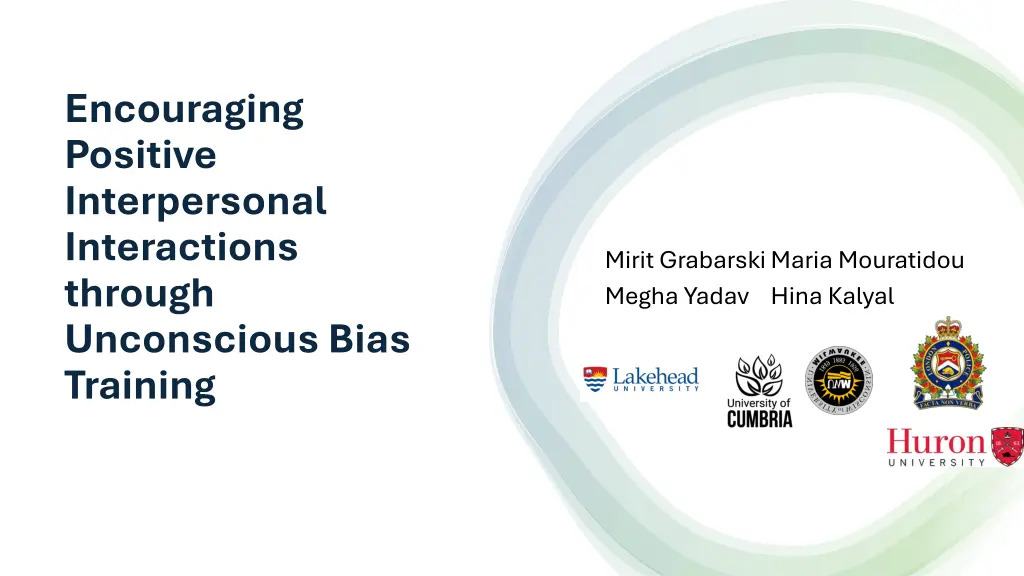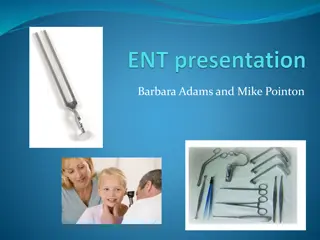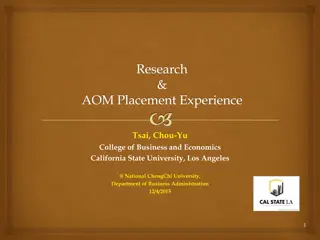
Encouraging Positive Interpersonal Interactions through Unconscious Bias Training
Explore how diversity training, particularly in police organizations, can address unconscious bias effectively. The study evaluates the impact of implicit bias training on participants' intentions and subsequent actions to reduce bias in interpersonal interactions. Hypotheses based on the Theory of Planned Behavior are tested and supported, highlighting the importance of training evaluation in shaping behavioral outcomes.
Download Presentation

Please find below an Image/Link to download the presentation.
The content on the website is provided AS IS for your information and personal use only. It may not be sold, licensed, or shared on other websites without obtaining consent from the author. If you encounter any issues during the download, it is possible that the publisher has removed the file from their server.
You are allowed to download the files provided on this website for personal or commercial use, subject to the condition that they are used lawfully. All files are the property of their respective owners.
The content on the website is provided AS IS for your information and personal use only. It may not be sold, licensed, or shared on other websites without obtaining consent from the author.
E N D
Presentation Transcript
Encouraging Positive Interpersonal Interactions through Unconscious Bias Training Mirit Grabarski Maria Mouratidou Megha Yadav Hina Kalyal
Diversity training Evolved significantly over the years Main purpose: to harness the benefits of organizational diversity while minimizing conflict. Few training programs have been effective. 2
Diversity training in police organizations Not many training programs have effectively addressed unconscious bias. The purpose of this study is to evaluate a training program that is expected to lead to positive reactions to achieve its end goal of reducing bias. 3
Theoretical Model Figure 1: Theoretical model Gender Race Conversation Program evaluation Intention Action Status 4
Hypotheses Based on the Theory of Planned Behavior, we suggest : Hypothesis 1: Training evaluation will be positively associated with intention. Hypothesis 2: Intention will be positively associated with interactions with others: a) conversations and b) actions. Hypothesis 3: The relationships between training evaluation and interactions will be mediated by intention. 5
Methodology Implicit bias training conducted from January to April 2023. The training was designed by Prof. Patricia Devine, an international expert on the topic. All the members of the organization participated in the training (N=900) and were invited to complete an online survey before and after the training. The current study is based on the post-training survey results. The final sample consisted of 189 participants (53% male, 89% white, 61% sworn officers). 6
Measures Program evaluation; Conversation; Action: Carnes et al. (2015), Devine et al, (2012), Scott et al, (2023) Intention: Campbell & Bauer (2020) Presentation title 7
Discussion We suggested that the relationship between the program evaluation and behavioral outcomes will be mediated by behavioral intentions, i.e., the person modifies their behaviors intentionally following a training program Our findings support this theorizing. While the relationship between training evaluation and conversations was only partially mediated by intentions, the relationship between training evaluations and actions was fully mediated, which highlights the role of individual cognitions and intentions that are prerequisite for taking action. Our findings identify an important cognitive component that needs to be included in diversity training programs in order to increase their effectivity, i.e. driving behavioral change. The design of the program should focus on the intentions of the trainees to modify their behaviors after training. 8
References Ajzen, I. 1985. From intentions to actions: A theory of planned behavior. In J. Kuhl & J. Beckman (Eds.), Action control: From cognition to behavior: 11-39. Heidelberg, Germany: Springer. Ajzen, I., & Fishbein, M. 1980. Understanding attitudes and predicting social behavior. Englewood Cliffs, NJ: Prentice Hall. Ajzen, I., & Fishbein, M. 2005. The influence of attitudes on behavior. In D. Albarrac n, B. T. Johnson, & M. P. Zanna (Eds.), The handbook of attitudes: 173-221. Mahwah, NJ: Lawrence Erlbaum. Campbell, M. R., & Brauer, M. (2020). Incorporating Social-Marketing Insights Into Prejudice Research: Advancing Theory and Demonstrating Real-World Applications. Perspectives on Psychological Science, 15(3), 608-629. https://doi.org/10.1177/1745691619896622 Carnes, M. L., Devine, P. G., Manwell, L. B., Byars-Winston, A., Fine, E., Ford, C. E., Forscher, P. S., Iaasc, C., Kaatz, A, Magua, W., Palta, M, & Sherridan, J. (2015). Effect of an intervention to break the gender bias habit: A cluster randomized, controlled trial. Academic Medicine, 90, 221-230. doi: 10.1097/ACM.0000000000000552 Devine, P. G., Forscher, P. S., Austin, A. J., & Cox, W. T. L (2012). Long-term reduction in implicit racial bias: A prejudice habit- breaking intervention. Journal of Experimental Social Psychology, 48, 1268-1278. doi:10.1016/j.jesp.2012.06.003 Scott, K. E., Ash, T. L., Immel, B., Liebeck, M. A., Devine, P. G., & Shutts, K. (2023). Engaging White parents to address their White Children s racial biases in the Black-White context. Child Development, 94, 74-92. https://doi.org/10.1111/cdev.13840 Presentation title 9
Thank you for your attention! Questions? 10






















